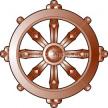Tibetan Buddhism

Bön was the name of natural, pre-Buddhist religion of Tibet. It is still practiced by part of the population and many of its elements have been integrated into Tibetan Buddhism.
“Compassion for all living things” is a key characteristic of the Tibetan Buddhism religion, however most Tibetans are not vegetarians and yak meat is a staple diet.
Tibetan Buddhism is made up of several main schools:
Over 6000 monasteries were in Tibet in the 1930s, less than 70 survived after the ‘democratic reform’ by the Chinese. In the nineties many were rebuilt from the rubble.
Monks take up 250 vows, nuns (ani) 360.
Muslims have been living in Tibet since its empire was bordering the Caliphate of Baghdad in the 8th century. Even today they are a significant minority. Habaling Khache is the name of the Lhasa Muslims. Surprisingly there is also a significant number of Chinese (Hui) Muslims.
Pilgrims to the Buddhist shrines make offerings of water and yak-butter lamps. Prostrating in front of important temples and holy places is a popular way of gaining religious merits.
Sky burials: Tibetans traditionally do not bury their dead – the bodies and left high in the mountains for the vultures. To make their job easier they are usually chopped into smaller pieces.
Reincarnation: Like all Buddhists the Tibetans believe in reincarnation of spirit, but while a normal person may be reincarnated as an animal or an insect some prominent lamas are reincarnated as other lamas. These prestigious reincarnations are called TULKU. Both the Dalai Lama and the Panchen Lama are reincarnated this way. Tulku reincarnations were introduced in the early XIV century as a means of preserving political power and influence. There are elaborate rituals for discovering the new incarnation of the lama who has died recently. They are very well depicted in the 1997 film ‘Kundun’ telling the story of the Dalai Lama.
The Dalai Lama. A lama is a spiritual leader, doesn’t have to be a monk. The title of DALAI (meaning ‘the ocean of wisdom’) is a Mongolian title. It was first awarded to Lama Sonam Gyatso by Altan Khan around 1580 AD. Because Sonam Gyatso was the third incarnation of the Lamas of the Gelug Order he became the Third Dalai Lama, and his two predecessors were given the titles of the First and the Second Dalai lamas posthumously. The current XIV Dalai Lama is Tenzin Gyatso. His photographs are illegal in Tibet. He has not been in his country since going into exile in 1959.
The Panchen Lama and the Dalai Lama are the two most important spiritual leaders of Tibet. A reincarnated Panchen Lama was traditionally ‘approved’ by a Dalai Lama. Since the 1950 invasion the Chinese Authorities reserve this function for themselves in spite of rejection of religion and not believing in reincarnation. The previous Panchen Lama died in 1989 and in 1995 his reincarnation was discovered. The authorities promptly took away the child and replaced him with their own candidate – a son of party officials. The real Panchen Lama hasn’t been seen since and is widely recognised as the youngest political prisoner in the world.
The Tibetan Government in Exile and His Holiness the Dalai Lama reside in Dharamsala in North India. Chances of his visit to Tibet are slim, in spite or signs of liberalisation there.To find out more about the Tibettan Buddhism see the Links section of this site.

